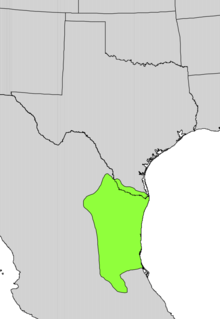Cordia boissieri
| Cordia boissieri | |
|---|---|
 | |
| Scientific classification | |
| Kingdom: | Plantae |
| (unranked): | Angiosperms |
| (unranked): | Eudicots |
| (unranked): | Asterids |
| Order: | (unplaced) |
| Family: | Boraginaceae |
| Genus: | Cordia |
| Species: | C. boissieri |
| Binomial name | |
| Cordia boissieri A.DC.[1] | |
 | |
| Natural range | |
Cordia boissieri is a species of flowering shrub or small tree in the borage family, Boraginaceae. Its native range extends from southern Texas in the United States south to central Mexico. Common names include anacahuita, Mexican olive,[1] white cordia, and Texas wild olive.[2] It is named after botanist Pierre Edmond Boissier.
Description
Cordia boissieri reaches a height of 5–7 m (16–23 ft), with a symmetrical round crown 3–5 m (9.8–16.4 ft) in diameter. The ovate leaves are 9–18 cm (3.5–7.1 in) long and 5–9 cm (2.0–3.5 in) wide.[3] It is evergreen but will lose leaves if it suffers frost damage[4] The white, funnel-shaped flowers are 3–5 cm (1.2–2.0 in) across[3] and are present on the tree throughout the year.[5] The drupes[6] are yellow-green, olive-like, and 1.2–2.4 cm (0.47–0.94 in) in length. They are sweet but slightly toxic when fresh, causing dizziness in humans and other animals.[3] The tree has a lifespan of 30-50 years.[7]
Uses
Jellies made from the fruits are reportedly safe to eat. A syrup made from the fruits is used to dye cloth and treat coughs. The leaves are used to alleviate rheumatism and pulmonary illness. The wood is used as firewood and for carpentry.[3] Anacahuita is cultivated as an ornamental for its compact size and showy flowers. It is hardy to USDA Zone 9a.[8]
Ecology
Cordia boissieri is a host plant for the wild olive tortoise beetle (Physonota alutacea).[9]
Symbolism
Anacahuita is the official flower of the state of Nuevo León in Mexico.[4]
References
| Wikimedia Commons has media related to Cordia boissieri. |
| Wikispecies has information related to: Cordia boissieri |
- 1 2 "Cordia boissieri". Germplasm Resources Information Network. United States Department of Agriculture. 2005-11-08. Retrieved 2009-12-09.
- ↑ Llamas, Kirsten Albrecht (2003). Tropical Flowering Plants: A Guide to Identification and Cultivation. Timber Press. p. 147. ISBN 978-0-88192-585-2.
- 1 2 3 4 Lara, Teresa Rojas; Robert E. Paull (2008). Jules Janick; Robert E. Paull, ed. The Encyclopedia of Fruit & Nuts. CABI. p. 187. ISBN 978-0-85199-638-7.
- 1 2 Mild, Christina (2003). "Cordia boissieri" (PDF). Rio Delta Wild. Retrieved 2009-12-09.
- ↑ "Cordia boissieri A. DC.". Native Plant Information Network. Lady Bird Johnson Wildflower Center. Retrieved 2009-10-20.
- ↑ "Wild Olive, Mexican Olive, Anacahuita Cordia boissieri". Texas Native Trees. Texas A&M University. Retrieved 2009-10-20.
- ↑ "A Guide to Growing Healthy Trees in the Lower Rio Grande Valley of Texas" (PDF). Valley Proud Environmental Council. 2007. Retrieved 2009-12-09.
- ↑ Gilman and, Edward F.; Dennis G. Watson. "Cordia boissieri: Wild-Olive". Electronic Data Information System. University of Florida IFAS Extension. Retrieved 2010-04-04.
- ↑ Quinn, Mike. "Wild Olive Tortoise Beetle Physonota alutacea Boheman, 1854". Texas Beetle Information. Texas Entomology. Retrieved 2010-04-04.
External links
- "Cordia boissieri" (PDF). Digital Representations of Tree Species Range Maps from "Atlas of United States Trees" by Elbert L. Little, Jr. (and other publications). United States Geological Survey.